 |
|
Wine Details
Price:
$65.00 per bottle
Description:
Folks, this is a beauty. Full of fresh berry and cherry from start to finish. Three bottle limit. The Cole Ranch AVA is California’s smallest appellation. This isolated viticultural area of less than one quarter square mile sits between the Russian River and Anderson Valley in Mendocino County. Here a mere sixty acres of Cabernet Sauvignon, Merlot and Riesling vines are found tucked into the high hills ranging from 1,400-1,600 feet in elevation. There are no resident wineries within the appellation itself, but the quality of Cole Ranch fruit has seen the trucks of several highly-regarded wineries making their way up to the remote little valley to purchased grapes and make wines with the Cole Ranch AVA designation. Today, the Sterling family, proprietors of the Esterlina Winery -- located at the western end of Anderson Valley -- owns the entire vineyard acreage of the appellation. Esterlina transports its Cole Ranch fruit down the road to be processed at their winery in Philo.
|
|
Varietal Definition
Pinot Noir:
The name is derived from the French words for ‘pine’ and ‘black’ alluding to the varietals' tightly clustered dark purple pine cone shaped bunches of fruit. Pinot Noir grapes are grown around the world, mostly in the cooler regions, but the grape is chiefly associated with the Burgundy region of France. It is widely considered to produce some of the finest wines in the world, but is a difficult variety to cultivate and transform into wine. By volume most Pinot Noir in America is grown in California with Oregon coming in second. Other regions are Washington State and New York.During 2004 and the beginning of 2005, Pinot Noir became considerably more popular amongst consumers in the United States, possibly because of the movie Sideways. Being lighter in style, it has benefited from a trend toward more restrained, less alcoholic wines. It is the delicate, subtle, complex and elegant nature of this wine that encourages growers and winemakers to cultivate this difficult grape. Robert Parker has described Pinot Noir: "When it's great, Pinot Noir produces the most complex, hedonistic, and remarkably thrilling red wine in the world."
|
Merlot:
Merlot is known as a Noble Bordeaux varietal. Although it came to France in the first century, it was not named until the 1880s. Merlot was originally used only for blending, as it is soft and compliant, very useful in softening other Bordeaux wines like Cabernets. Recently in California and Chile it became popular as a 100% varietal wine. Merlot tends to be easier to grow in a variety of soil conditions and is harvested earlier in the year than Cabernet. Although most Merlots are made to be drunk earlier, there are many with complexities of a Cabernet. Flavors of plum, black cherry, violet, chocolate and orange pair well with rich, red pasta dishes, hearty chicken dishes, and any beef combination that you fancy. The perfect match of course is chocolate. Not only does the chocolate compliment the wine and vice-versa, but the essence of both flavors linger eternally.
|
Riesling:
On the sweeter end of the spectrum, some of the best dessert wines should give thanks to the Riesling varietal. Riesling is known for its complementary nature of combining balanced acidity with sugar. Rieslings are made dry to sweet, but it is the sweet style Riesling that brought about its popularity in the United States. With the rise of spicy sauces, marinades and dips to flavor our meal, Riesling plays a part in taking off the edge of the heat. Riesling is known for a number of signature characteristics: floral, citrus and pear. Riesling has peaked in California with 11,000 acres planted. Today, Monterey County’s cool-climate areas and its long growing season produce good amounts of character for the Riesling grape. Outside of
|
Cabernet Sauvignon:
Cabernet Sauvignon is the most widely planted and significant among the five dominant varieties in France’s Bordeaux region, as well as the most successful red wine produced in California. Though it was thought to be an ancient variety, recent genetic studies at U.C. Davis have determined that Cabernet Sauvignon is actually the hybrid offspring of Sauvignon Blanc and Cabernet Franc. Cabernet Sauvignon berries are small with black, thick and very tough skin. This toughness makes the grapes fairly resistant to disease and spoilage and able to withstand some autumn rains with little or no damage. It is a mid to late season ripener. These growth characteristics, along with its flavor appeal have made Cabernet Sauvignon one of the most popular red wine varieties worldwide.
|
|